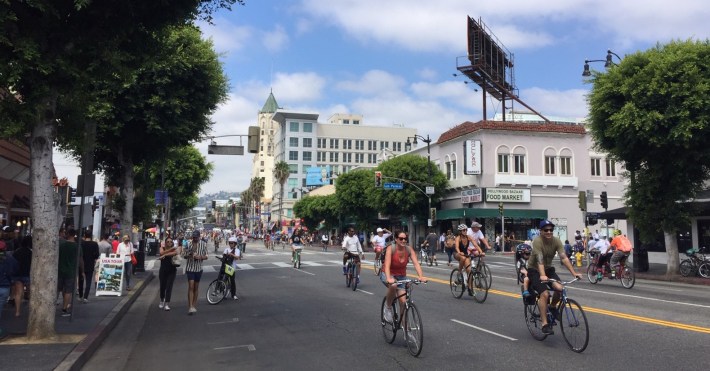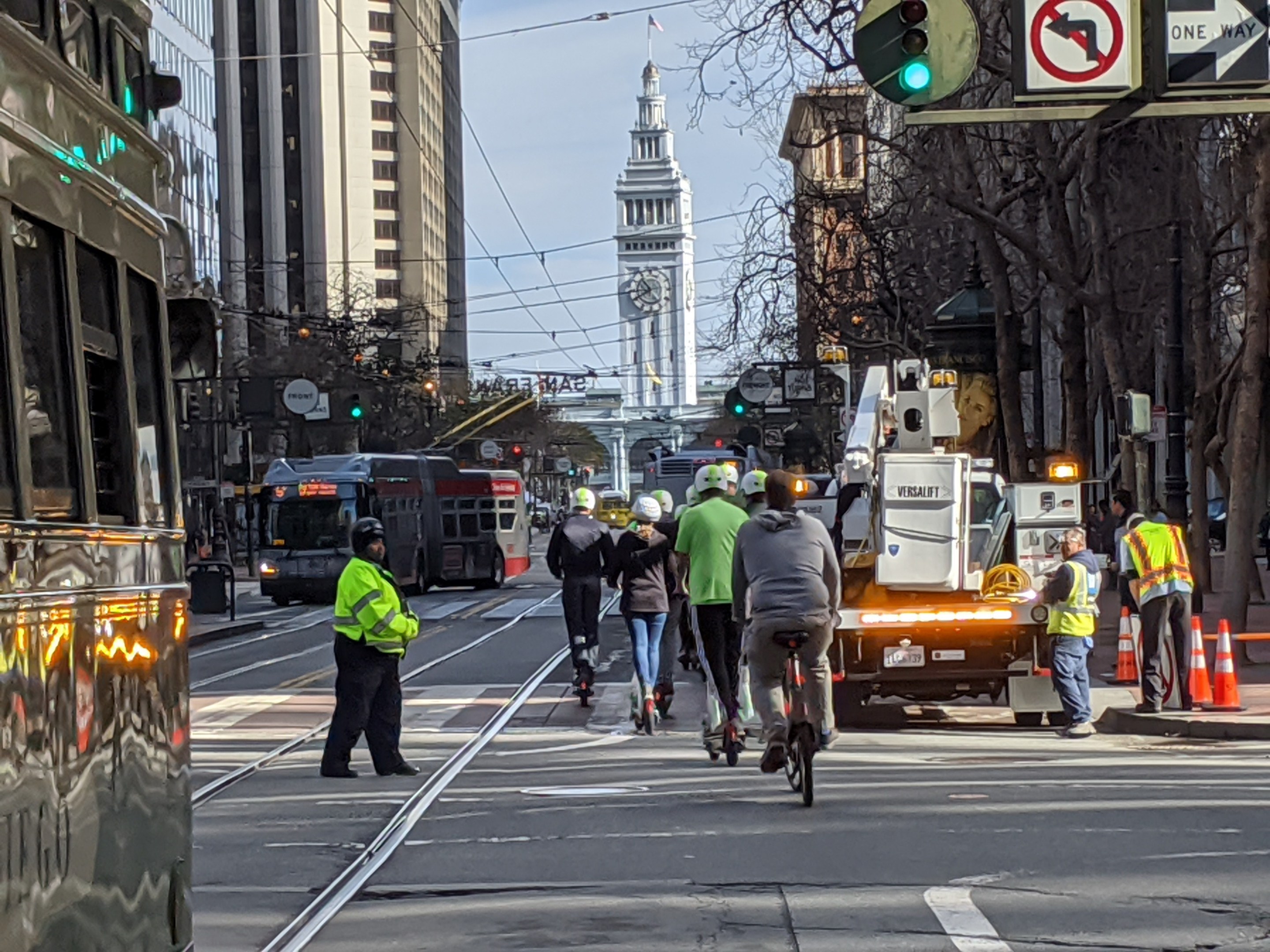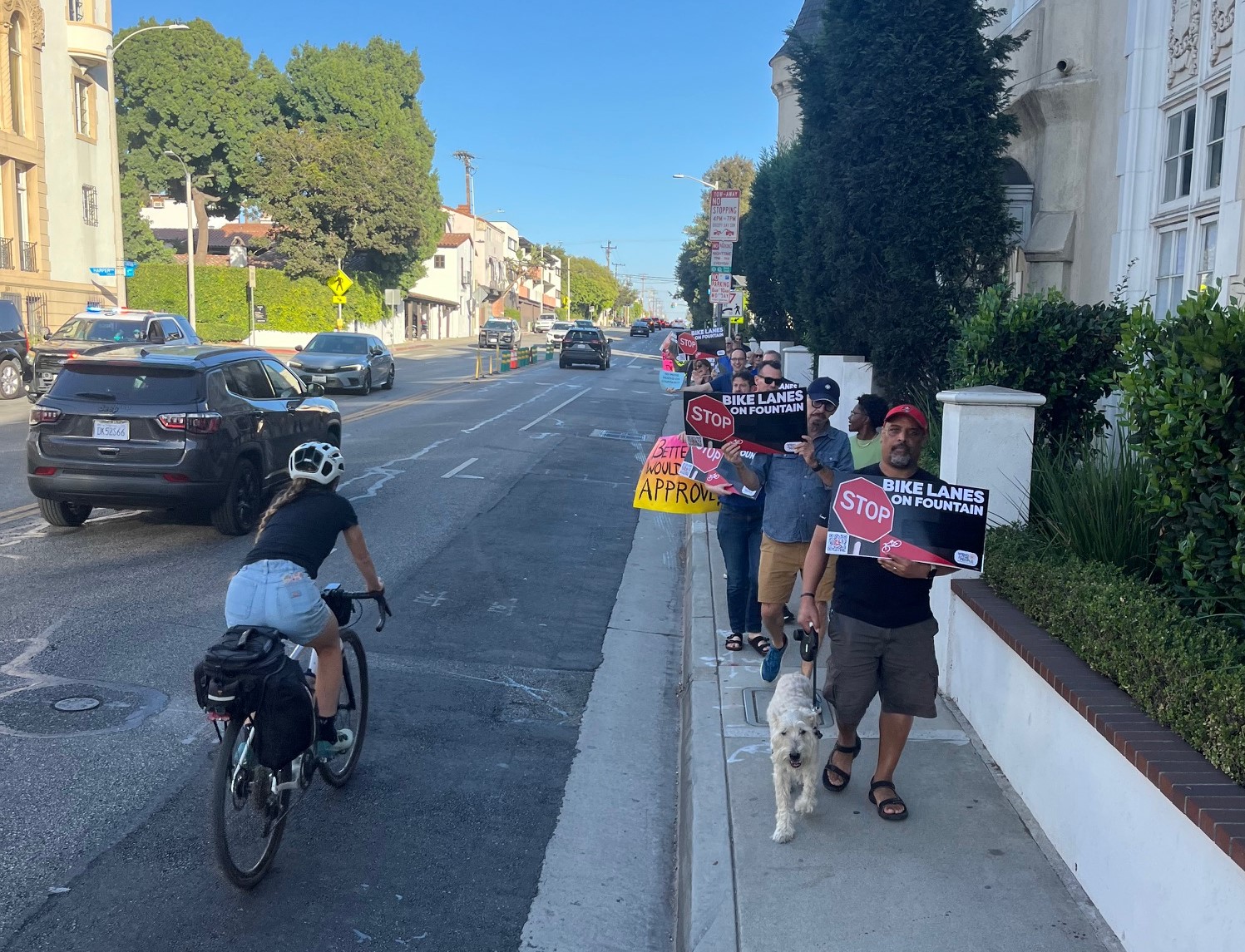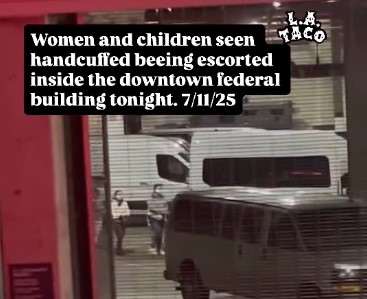Yesterday, San Francisco closed 2.2 miles of its busy central Market Street to cars. The city's Better Market Street project makes the corridor safer and prioritizes getting around more efficiently by foot, transit, and bike. The newly car-free street was the culmination of many years of advocacy and planning. Despite some whiny windshield reporting, the project's opening was greeted enthusiastically by elected officials, businesses, community groups, and plenty of people using Market Street.
In October 2019, New York City did a somewhat similar project, banning cars and prioritizing buses on 14th Street. CityLab's Market Street coverage cites a trend in many cities around the world pedestrianizing core streets, including Madrid and Birmingham.
Early L.A. Times coverage focused on confused drivers and bike-car conflict portrayed as cyclists gesturing at drivers (as opposed to the real conflict - mentioned later in the article - drivers killing and injuring cyclists), but today the Times editorial board weighed in challenging L.A. to follow suit:
Los Angeles surely has similar corridors that could go car-free, either completely or maybe just one day a week to test it out. Broadway, for example, has already been narrowed in the downtown core to make room for outdoor plazas. CurbedLA suggested other marquee streets, like Grand Avenue and Hollywood Boulevard, that could benefit from banishing cars. In his Green New Deal, in which he lays out his sustainability goals, Garcetti calls for 50% of all trips in the city by 2035 to be made by walking, biking and taking transit. But that goal will be impossible without the political will to prioritize other modes of transportation and the infrastructure and transit improvements that make it easier, safer and more pleasant for people to get around.
San Francisco and other major cities are showing the way. To fight climate change and design healthier communities, cities have to reclaim streets from cars.
State Senator and L.A. City Council candidate Kevin de Leon tweeted that a video of San Francisco's Market Street is "surreal" and that "we can do this in DTLA easy!"
This video is so surreal! If New York City can shut down Times Square, and San Francisco can shut down Market Street - we can do this in #DTLA easy! https://t.co/G85XDPj3E4
— Kevin de Leόn (@kdeleon) January 29, 2020
As San Francisco, New York, and others have shown, car-free streets don't banish transit buses, but actually serve to speed up transit.
Also, car-free doesn't have to be 24/7, but could allow for morning deliveries, then prioritize walking/transit/bicycling at specific times, like afternoons, evenings, and weekends. CicLAvia has shown that streets crowded with cars on Sarturdays can be full of bikes and pedestrians on Sundays.
Readers, where would you like to see L.A. do car-free streets? Last year Curbed proposed seven streets. Below is an overlapping list of ten potential car-free candidates. All of these would require plenty of coordination with stakeholders, businesses, transit agencies, etc., but if San Francisco can this, so can Southern California.
Below is Streetsblog L.A.'s list of ten potential car-free street candidates:
1. Alvarado Street - in Westlake/MacArthur Park/Pico Union - perhaps from 6th Street to Olympic Boulevard
Proposed by Curbed, Alvarado definitely sees many transit riders and lots of pedestrians; it's one of the most walked areas in Southern California. The low-income Latinx immigrant community is rich with street vending, but currently impacted by gentrification. Metro has regulated street vending around its subway station there, largely to the detriment of an informal organic assortment of vendors that activates and serves the pedestrian traffic. Gentrification is also driving away community-serving spaces, including CARECEN's nearby day laborer center. A car-free Alvarado would need to build on Alvarado's existing strengths, not exacerbate the displacement that is already weakening it. Any car-free transformation of Alvarado should therefore be cognizant of the needs and aspirations of the area's low-income residents and vendors, reflect and celebrate immigrant Latinx culture, and be welcoming to families, the young, and old.
2. Arizona Avenue - in Santa Monica - perhaps from Ocean Avenue to Lincoln Boulevard
Arizona is a fairly quiet street between busy Wilshire and Santa Monica Boulevards. With bike lanes, the street is well used by pedestrians and cyclists. The city of Santa Monica could make it even safer and more desirable by making several blocks car-free.
3. Broadway - in downtown Los Angeles - perhaps from First Street to 11th Street
Broadway is arguably somewhat similar to Market Street in San Francisco. It's a central downtown corridor with lots of pedestrians and plenty of bus transit. Tepid efforts, Bringing Broadway Back and Broadway's Dress Rehearsal, have made small positive steps toward reclaiming space sacrificed to car traffic, but haven't succeeded in transforming Broadway into the great pedestrian street it once was. Maybe closing a dozen blocks off to car traffic would do the trick.
4. Broxton Avenue - in Westwood - for the entire length from Le Conte Avenue to Kinross Avenue
For too long, Westwood Village has tried to kickstart a sputtering revitalization by catering to drivers and parking. Better to acknowledge that the once-thriving commercial district would be better served by catering to people on foot, bike, and transit. Ideally, this would mean making parts of Westwood Boulevard car-free, but current leadership has railed against even simple no-lane-removal bike lanes there, so perhaps Broxton could serve as proof of concept first.
5. Colorado Boulevard - in Pasadena - perhaps from the 710 Freeway stub to Lake Avenue
Pasadena's Colorado Boulevard spills over with pedestrians during afternoons, evenings, and weekends. While the city fosters walkability with scramble crossings, and smart parking policy, why not give Colorado's pedestrians the space they need by making portions of the street car-free?
6. Degnan Boulevard - in Leimert Park Village - perhaps from 43rd Street to 43rd Place
Leimert Park Village, an important center for L.A.'s Black communities and cultures, is being squeezed by gentrification and speculation, fueled by the pending arrival of Metro's Crenshaw subway. Stakeholders have been formally organizing to harness change and strengthen the foothold of Black creatives and innovators in the community since 2014. Building on Leimert Park People St Plaza and recent local visioning processes, streets around the village have already been envisioned as car-free, or at least car-lite, potentially even with self-driving shuttles serving as cultural portals. A car-free Degnan could be an extension of Destination Crenshaw - an unapologetically Black-centered public art project running from Slauson to Expo - and build on Leimert Park's Afro-futurist vision and cultural programming.
7. Grand Avenue - in downtown L.A. - perhaps from Cesar Chavez Avenue to 4th Street
With museums and music venues, Grand should be a place where locals and tourists linger and enjoy themselves, not a place where cars dash through quickly. Getting there by transit will be even easier in a couple years with the opening of the Metro Regional Connector subway. Especially on weekends, foot traffic is heavy and car traffic is light, so Grand would be great car-free.

8. Hollywood Boulevard - in Hollywood - perhaps from La Brea Avenue to Gower Street
Hollywood is a worldwide tourist destination, though it is said that millions of visitors go there every year, and they only stay for about 15 minutes, because it just isn't a place that anyone wants to linger in. The sidewalks are crowded with pedestrians. The place is very transit-accessible by bus or via the Metro B (Red) Line. There's no place to sit or hang out. There are tepid master planning efforts underway, which look to widen some sidewalks and plant some trees... but why not really make Hollywood pedestrian-friendly by making it fully car-free? Streets for All and others are pushing for permanent closures of parts of Hollywood Boulevard. The street is already closed frequently for film industry events. Street closures could be seasonal, piloted soon, perhaps on weekends during the summer tourist season?
9. Lankershim Boulevard - in North Hollywood - perhaps from Burbank Boulevard to Camarillo Street
The North Hollywood Arts District is a great destination, with plenty of sidewalk eateries and arts venues. Lankershim cuts through it like a big barrier, isolating pedestrians, and cutting the area off from easy walk and bike access to the NoHo B (Red) Line station. Recurring weekend closures of Lankershim could activate NoHo, supporting cultural programming and business, and bringing people together in the most transit-rich neighborhood in the Valley.
10. Ocean Avenue - in Santa Monica - from the California Incline to Santa Monica Pier
Both sides of Ocean Avenue thrive with tourist activity, but unfortunately there's a big wide car-choked street in the middle. Santa Monica has done a lot to enhance walkability, especially downtown, so a car-free Ocean Avenue could build on that success.
(Thanks to my on-background sources for strengthening this post.)







